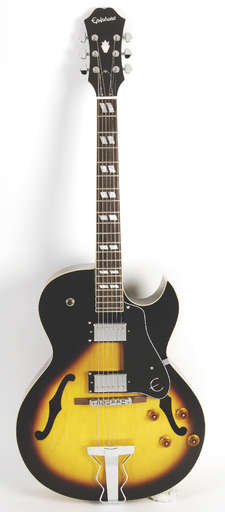MusicRadar Verdict
It will satisfy anyone who's hankered after a no-frills archtop jazzer.
Pros
- +
An affordable jazzer that doesn't skimp on the spec.
Cons
- -
The pickups can be a tad unbalanced a times.
MusicRadar's got your back
Gibson made its reputation on big archtop guitars and none is more famous than the ES-175, a single-cut semi that came to the fore in 1949 and has been with us ever since.
Now that Gibson only offers the majority of the ES guitars through its Custom Shop facility, this limited edition from Epiphone may prove to be the saving grace for jazzers on a budget.
This Epiphone version remains true to the original spec. The back, sides and top are all constructed from a five-ply maple laminate (not mahogany, as www.epiphone.com would have us believe).
At 88mm at its edge, the body is certainly deep and, unlike the thinner ES-335 and associated models, there's no centre block here aside from a strip of maple that resides on the underside of the top upon which the pickups are mounted.
This ensures that the guitar isn't overly weighty and that as much of the cubic volume as possible is employed to produce the tone.
The split-block rosewood 'board and bound neck are nicely finished - although the classy vibe is somewhat let down by a cheap-looking white plastic nut - and the classic Florentine cutaway allows unrestricted access to all frets. Internally proceedings are neat and tidy.
The f-holes are a little messy in places but the subtle grain of the maple is the final cherry on top of what is an attractive instrument.
Want all the hottest music and gear news, reviews, deals, features and more, direct to your inbox? Sign up here.
Sounds
Of course there's much more to an archtop than jazz - just ask Ted Nugent - but there's no denying that, when using a clean sound through a good amp, the woody mellowness of the neck humbucker is perfectly suited to that style of player.
Thoughtfully strung out of the box with a set of 12s (we guesstimate), complete with a wound third, the low action makes complex chords and runs a doddle, and there's enough 'fight' from the guitar to keep the more proficient of jazzers interested.
Opting to add a touch of bite from your amp, the guitar responds just as efficiently and even though there's a definite upper limit to the amount of gain the 175 can handle, the additional sustain afforded by such an action works wonders for blues.
Believe us, there are not many of you reading this that wouldn't benefit from owning this ES-175 irrespective of your style. The impressive price is backed up with an acceptable construction quality and excellent tonal performance.
In the tone stakes it ticks all the boxes required for an affordable jazz guitar and, as we've said, it's good enough to be used for other styles too.
Simon Bradley is a guitar and especially rock guitar expert who worked for Guitarist magazine and has in the past contributed to world-leading music and guitar titles like MusicRadar (obviously), Guitarist, Guitar World and Louder. What he doesn't know about Brian May's playing and, especially, the Red Special, isn't worth knowing.
